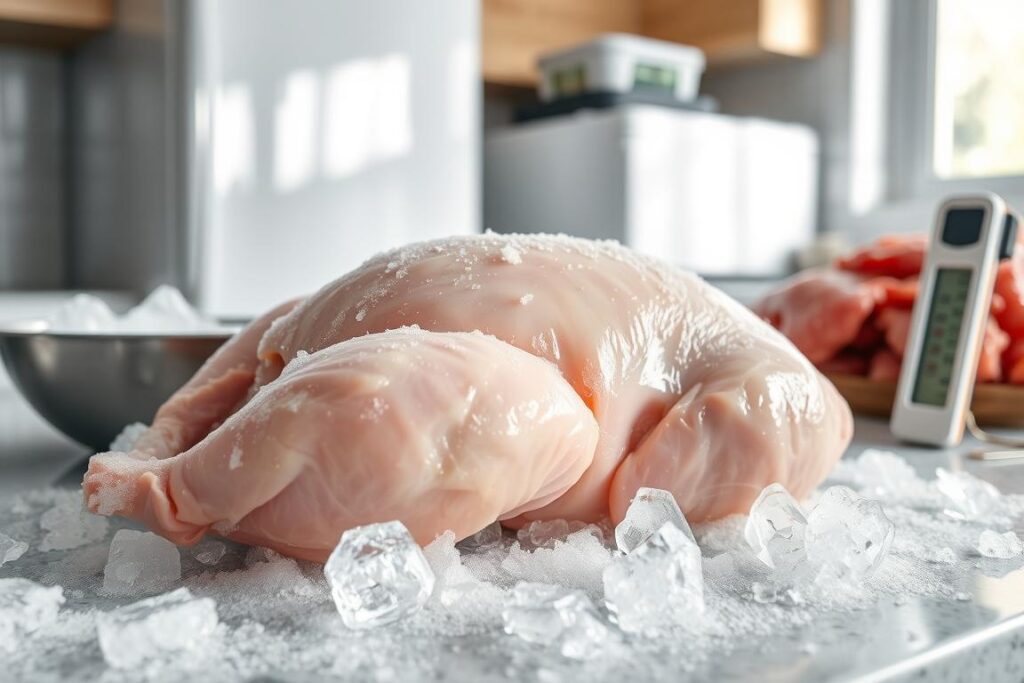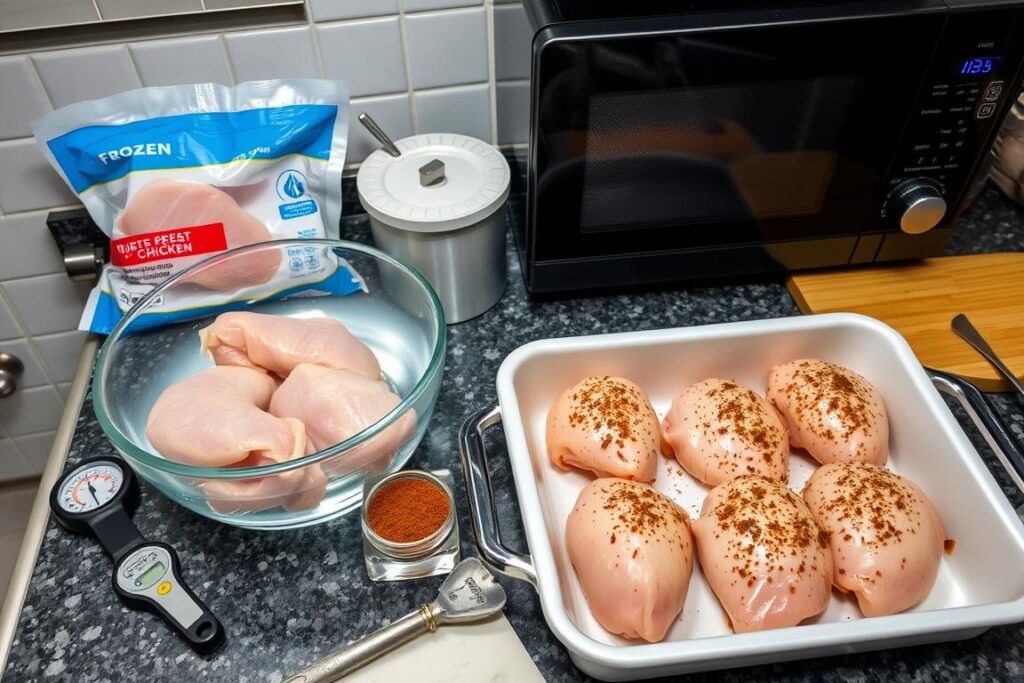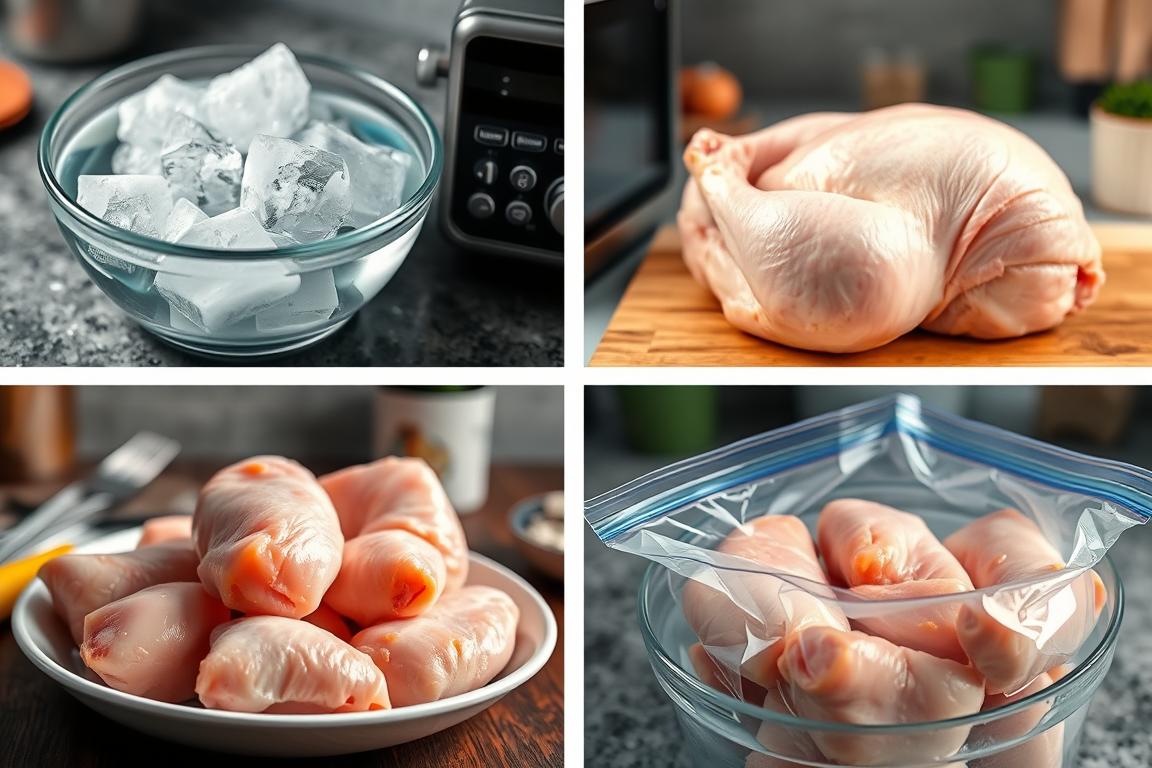Last weekend, I stared into my freezer, a package of frozen chicken breasts in hand. I was wrestling with a question many home cooks face: Do I really need to fully defrost this chicken before cooking? The answer might surprise you.
Americans eat more chicken than any other meat. This makes safe chicken handling critical in every kitchen. Whether you’re a busy parent or a home chef, knowing how to defrost chicken can change your cooking.
Raw chicken can have dangerous bacteria like Salmonella and Campylobacter. Your safety depends on knowing how to handle frozen chicken right. Thawing chicken isn’t just about making things easier—it’s about keeping your family healthy.
Professional chefs and food safety experts have set guidelines for thawing chicken safely. This article will show you the key techniques for safe chicken handling. This way, your meals will be not just tasty but also safe to eat.
Understanding the Importance of Proper Chicken Thawing
Keeping your family safe from foodborne illnesses is key when cooking chicken. The first step is to thaw chicken safely. This step is vital to stop bacteria from growing.

Chicken needs extra care when it comes to food safety. Thawing frozen chicken correctly is important for its safety and quality.
Temperature Danger Zone Explained
Chicken is at risk of bacterial contamination in the “temperature danger zone” – between 40°F and 140°F. In this range, harmful bacteria can grow fast, raising the risk of getting sick.
- Bacteria double every 20 minutes in the danger zone
- Proper thawing prevents uneven temperature distribution
- Consistent temperature control is key to food safety
Bacterial Growth Risks
Chicken cooking temperatures are crucial to kill off harmful bacteria. Bacteria like Clostridium perfringens can form heat-resistant spores if chicken is thawed wrong. This can make it hard to cook the chicken enough to kill these spores.
To avoid getting sick, it’s important to know these risks. Always thaw chicken safely to keep your family healthy.
Does frozen chicken need to be fully defrosted?
Cooking frozen chicken can be tricky. Many home cooks wonder if they need to fully defrost it. The answer depends on your cooking method and how much time you have. Preparing frozen meat requires careful thought to ensure safety and taste.

You don’t always need to fully defrost chicken before cooking. Different cooking techniques offer various approaches:
- Pressure cookers can cook frozen chicken directly
- Oven baking requires partial or complete thawing
- Grilling works best with thawed chicken
The USDA says your chicken must reach 165°F (74°C) inside, no matter if it’s frozen or thawed. Cooking times will increase by about 50% if starting with frozen meat.
| Cooking Method | Defrosting Required | Estimated Time Increase |
|---|---|---|
| Instant Pot/Pressure Cooker | No | Minimal |
| Oven Baking | Recommended | 50% |
| Grilling | Yes | 50% |
Pro tip: If you’re short on time, use the microwave’s defrost setting or a cold water bath to speed up thawing. Always check the internal temperature to ensure it’s safe to eat.
Safe Methods for Thawing Chicken
Defrosting chicken right is key for safe food handling. Knowing the best ways to thaw chicken helps you cook meals fast and safely. Each method has its own benefits, based on how much time you have and your kitchen setup.
Refrigerator Method: Slow but Safest Approach
The fridge method is the safest way to thaw chicken. It takes planning but keeps bacterial growth low.
- Place frozen chicken in a container to catch drips
- Keep chicken on the bottom shelf of the refrigerator
- Allow 24 hours of thawing time for every 5 pounds of meat
Cold Water Thawing Technique
The cold water method is faster than the fridge method. It needs more effort but cuts down on waiting time.
- Seal chicken in a leak-proof plastic bag
- Submerge in cold tap water
- Change water every 30 minutes
- Small packages typically thaw in 1-2 hours
Microwave Defrosting Guidelines
Microwave thawing is the quickest method. But, you must cook it right away to avoid bacterial growth.
- Use the defrost setting on your microwave
- Rotate and flip chicken during process
- Cook immediately after microwaving
| Thawing Method | Time Required | Safety Level |
|---|---|---|
| Refrigerator | 24 hours per 5 lbs | Highest |
| Cold Water | 1-2 hours | Moderate |
| Microwave | 5-10 minutes | Lowest |
Pro tip: Always cook chicken immediately after thawing to ensure food safety and prevent bacterial growth.
Common Chicken Thawing Mistakes to Avoid
Safe chicken handling is all about paying attention to details. Many home cooks make mistakes that can harm food safety and increase illness risks.
To avoid foodborne illness, it’s important to know the common thawing mistakes. Here are the main ones to watch out for:
- Countertop Thawing: Leaving chicken at room temperature is risky. The USDA says perishable foods should not stay out for more than two hours. Bacteria grow fast when chicken is between 40-140 degrees Fahrenheit.
- Hot Water Defrosting: Using hot water is not good. It causes uneven thawing and raises the risk of bacterial growth.
- Microwave Mistakes: Microwaves can be convenient but also risky. They can create hot spots that help bacteria grow and harm meat quality.
Research from the University of Zaragoza’s AgriFood Institute of Aragon shows some surprising facts. Perforated food pans can increase pathogenic bacteria by 25%. This is compared to just 2% in non-perforated containers.
Safe thawing methods are key to food safety:
- Refrigerator thawing (12-24 hours depending on chicken cut)
- Cold water thawing (1-3 hours, changing water every 30 minutes)
- Keeping temperatures below 40°F consistently
Keep yourself and your family safe by following proper chicken handling. Remember, taking shortcuts when thawing chicken can be very dangerous.
Conclusion
Dealing with frozen chicken needs careful food safety steps. Knowing how to thaw it right can greatly improve taste and health. Safe chicken handling is key to enjoying every meal without worry.
The fridge method is the best way to thaw chicken. It makes your frozen chicken safe and tasty. Boneless cuts thaw in 12 to 24 hours, while whole chickens take up to two days. This slow thawing keeps the chicken safe and fresh.
Food safety is more than just thawing. Remember, whole chickens can stay frozen for 1 year, and chicken pieces for 9 months. By following these tips and handling chicken safely, you’ll make meals that are both delicious and safe for your family.
Learning to thaw chicken well is about being patient, informed, and careful. Whether it’s a quick dinner or a big weekend meal, these guidelines will help you make a healthy, tasty dish from frozen chicken.
FAQ
Can I cook chicken directly from frozen?
Cooking chicken from frozen is possible, but thawing is usually better. It takes about 50% longer to cook frozen chicken. Make sure it reaches 165°F (74°C) inside. Pressure cookers like the Instant Pot can cook frozen chicken safely without thawing.
But for most methods, thawing makes cooking more even and improves texture.
What is the safest method to thaw chicken?
Refrigeration is the safest but slowest way to thaw chicken. It takes about 24 hours for every 5 pounds. This method keeps the chicken at a safe temperature and prevents bacteria growth.
Always thaw chicken on a plate or in a container to catch drips and prevent cross-contamination.
How long can chicken stay in the temperature danger zone?
Chicken should not stay in the danger zone (40°F to 140°F) for more than 2 hours. Bacteria like Campylobacter and Salmonella grow fast in this range. Always thaw chicken safely and cook or refrigerate it quickly.
Can I thaw chicken on the counter?
No, thawing chicken on the counter is unsafe. It allows bacteria to grow quickly, increasing foodborne illness risk. Use safe thawing methods like refrigeration, cold water, or microwave defrosting.
Always keep the chicken out of the danger zone during thawing.
How quickly can I thaw chicken using cold water?
Cold water thawing is faster, taking about 1-2 hours for small packages. Change the cold water every 30 minutes to keep it cold. Use a leak-proof bag to prevent water contamination and ensure even thawing.
Is microwave thawing recommended for chicken?
Microwave thawing is quick but has cautions. It may partially cook the chicken and requires immediate cooking to prevent bacterial growth. Cook the chicken immediately after thawing and ensure it reaches 165°F (74°C).
This method is best for small portions that will be cooked right away.
What are the signs of improperly thawed chicken?
Signs of improperly thawed chicken include an off smell, slimy texture, or discoloration. If the chicken looks gray, smells strong, or feels sticky, it may have been exposed to unsafe temperatures. When in doubt, discard the chicken to prevent foodborne illness.

